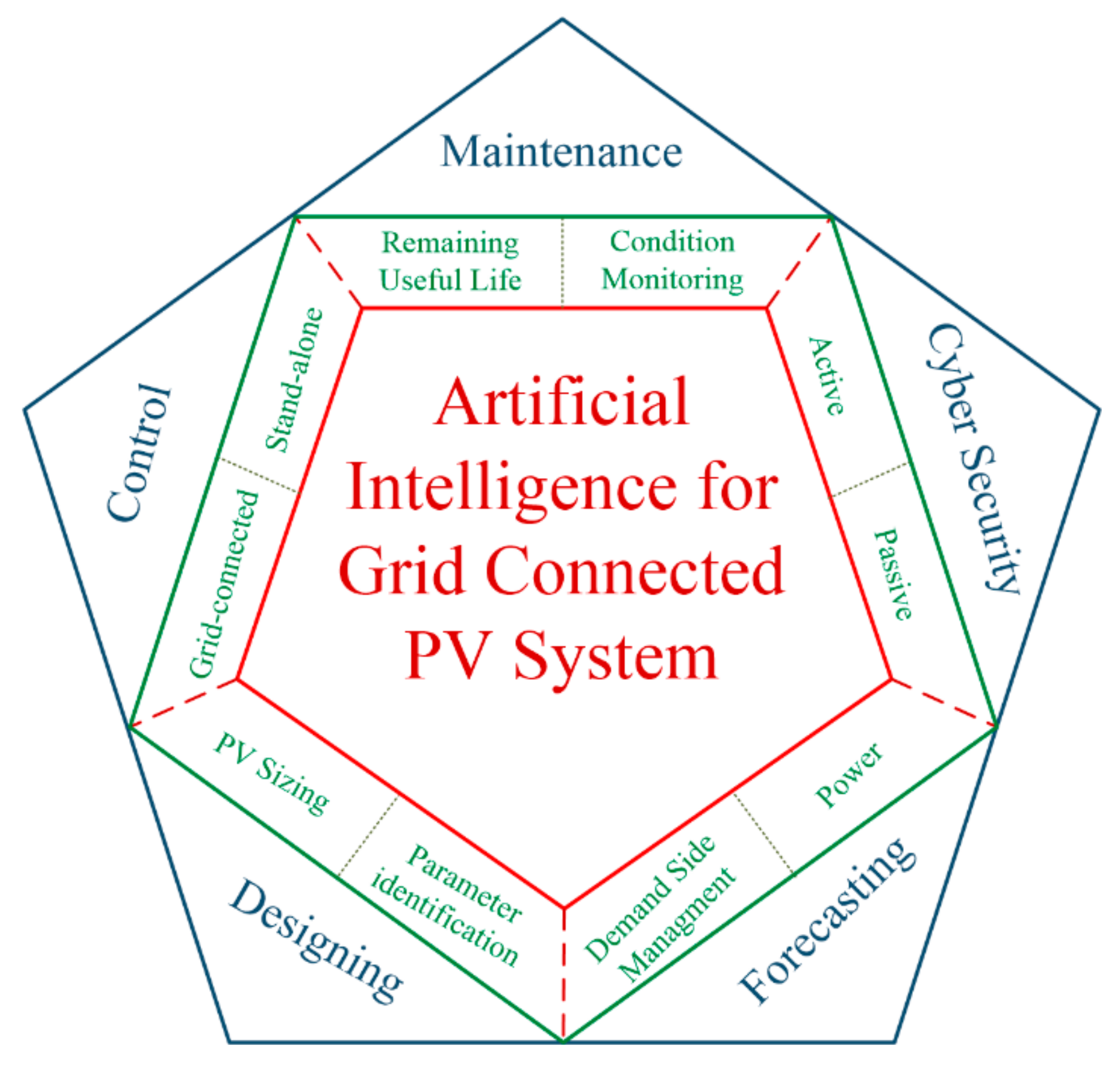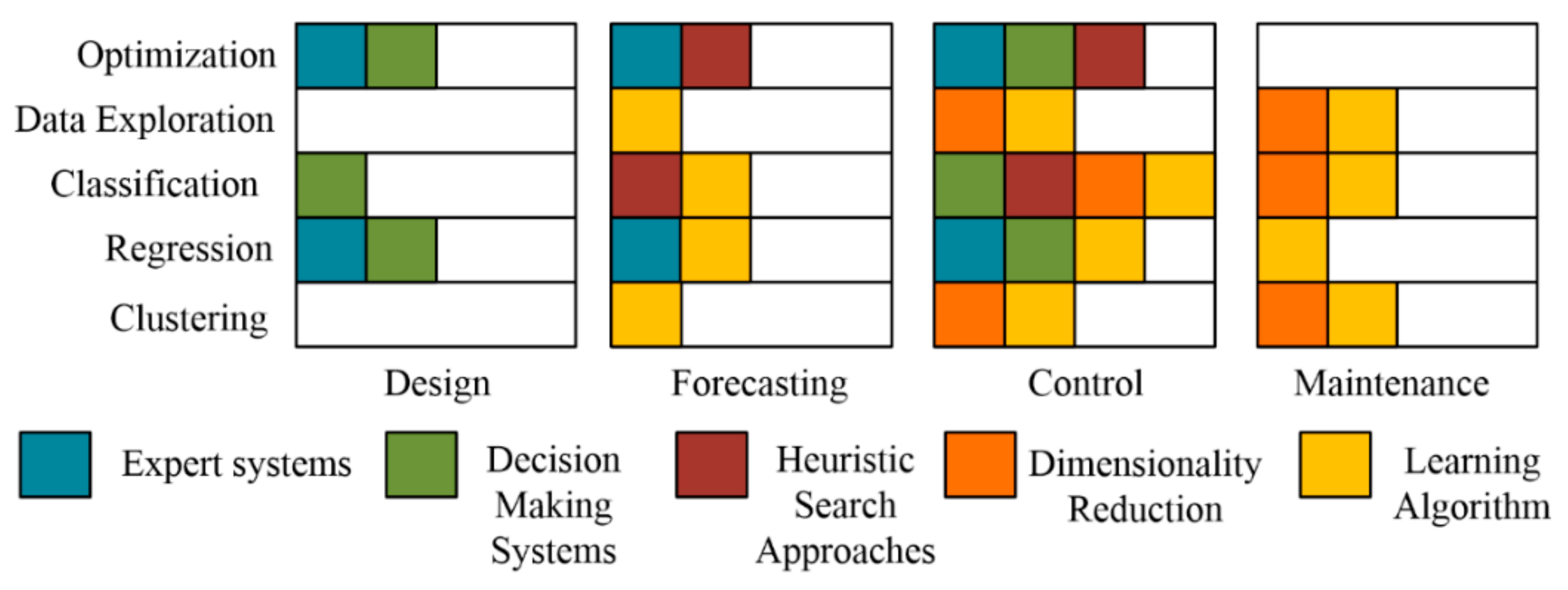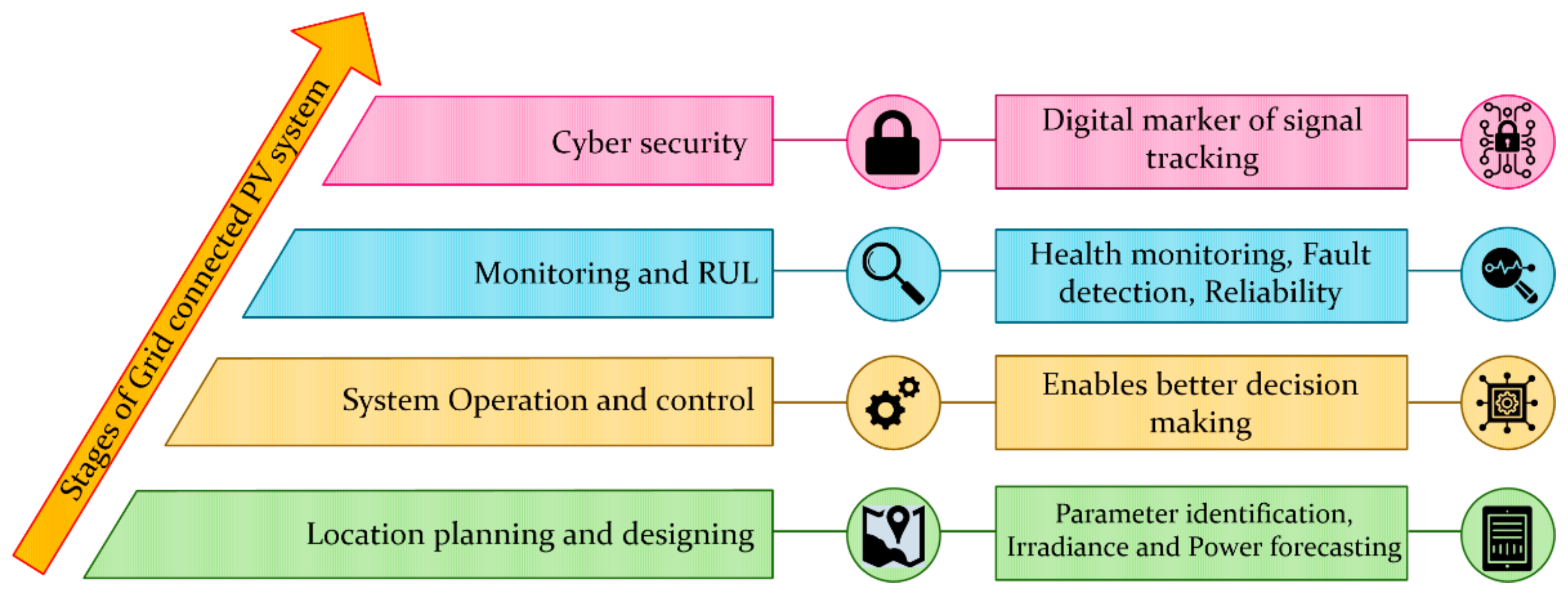
| Version | Summary | Created by | Modification | Content Size | Created at | Operation |
|---|---|---|---|---|---|---|
| 1 | Mohammed Ali Khan | -- | 2317 | 2022-08-29 11:19:01 | | | |
| 2 | Peter Tang | Meta information modification | 2317 | 2022-08-30 02:48:03 | | |
Video Upload Options
The use of artificial intelligence (AI) is increasing in various sectors of photovoltaic (PV) systems, due to the increasing computational power, tools and data generation.
1. Introduction


2. AI Framework for Grid Connected Photovoltaic Systems


|
Conventional Algorithms |
Application |
Advantages |
Drawback of Conventional Algorithms |
Solution with AI |
AI Techniques |
|---|---|---|---|---|---|
|
Predictive and stochastic methods |
Monitoring and Maintenance |
Simple implementation, Better Interpretability |
Sensitive to outliers |
Replace Outliers with a suitable value using Quantile Methods |
|
|
Data Minimization Approaches |
Maintenance |
Flexible framework |
Can only be used with clustering and intelligent approaches |
Replace data minimization approaches with filtering and normalization approaches |
|
|
Kernel based approaches |
Control and Maintenance |
Uncertainty Quantification, Better approximation capability, Computational Efficiency |
Probabilistic output, long training time |
Probabilistic outcomes are overcome with predictability, which uses statistics to analyze the frequency of past successful and unsuccessful events, and solves training sets locally to minimize the training time. |
|
|
Randomized Probabilistic approaches |
Maintenance |
Better Interpretability |
Complex computations, and Probabilistic output with random variables |
Uses symbolic reasoning to solve complex computations. |
|
|
Population based methods |
Design control and maintenance |
Parallel Capability, Achieved global convergence |
Complex implementation approach, less convergence speed |
Achieves pre-training with a pretty small learning rates to achieve fast convergence |
|
|
Trajectory based methods |
Control |
Simple implementation, Fast convergence |
Has local optima, and no parallel capability |
Work on uncertain jump positions and are less susceptible to premature convergence and less likely to be stuck in local optima. |
|
3. Application of AI for Power System Design
4. Application of AI for Forecasting in Grids with Photovoltaic Systems

5. Application of AI for Power Electronics Converter Control
References
- Bryson, J.J. The Past Decade and Future of AI’s Impact on Society. In Towards a New Enlightenment; Turner: Madrid, Spain, 2019.
- Zhao, S.; Blaabjerg, F.; Wang, H. An Overview of Artificial Intelligence Applications for Power Electronics. IEEE Trans. Power Electron. 2021, 36, 4633–4658.
- Mellit, A.; Kalogirou, S.; Hontoria, L.; Shaari, S. Artificial intelligence techniques for sizing photovoltaic systems: A review. Renew. Sustain. Energy Rev. 2009, 13, 406–419.
- Raza, M.Q.; Khosravi, A. A review on artificial intelligence based load demand forecasting techniques for smart grid and buildings. Renew. Sustain. Energy Rev. 2015, 50, 1352–1372.
- Khan, M.A.; Haque, A.; Kurukuru, V.B. Performance assessment of stand-alone transformerless inverters. Int. Trans. Electr. Energy Syst. 2020, 30, e12156.
- Ongsakul, W.; Dieu, V.N. Artificial Intelligence in Power System Optimization; Informa UK Limited: London, UK, 2016.
- Kurukuru, V.S.B.; Blaabjerg, F.; Khan, M.A.; Haque, A. A Novel Fault Classification Approach for Photovoltaic Systems. Energies 2020, 13, 308.
- Sahoo, S.; Dragicevic, T.; Blaabjerg, F. Cyber Security in Control of Grid-Tied Power Electronic Converters–Challenges and Vulnerabilities. IEEE J. Emerg. Sel. Top. Power Electron. 2020, 1, 1–15.
- Zernichow, B.M. Usability of Visual Data Profiling in Data Cleaning and Transformation; University of Oslo: Basel, Switzerland, 2017.
- Saez-de-Ibarra, A.; Milo, A.; Gaztanaga, H.; Debusschere, V.; Bacha, S. Co-Optimization of Storage System Sizing and Control Strategy for Intelligent Photovoltaic Power Plants Market Integration. IEEE Trans. Sustain. Energy 2016, 7, 1749–1761.
- Molzahn, D.K.; Dörfler, F.; Sandberg, H.; Low, S.H.; Chakrabarti, S.; Baldick, R.; Lavaei, J. A Survey of Distributed Optimization and Control Algorithms for Electric Power Systems. IEEE Trans. Smart Grid 2017, 8, 2941–2962.
- Xiao, R.; Xiang, Y.; Wang, L.; Xie, K. Power System Reliability Evaluation Incorporating Dynamic Thermal Rating and Network Topology Optimization. IEEE Trans. Power Syst. 2018, 33, 6000–6012.
- Da Costa, L.C.; Thome, F.S.; Garcia, J.D.; Pereira, M.V.F. Reliability-Constrained Power System Expansion Planning: A Stochastic Risk-Averse Optimization Approach. IEEE Trans. Power Syst. 2021, 36, 97–106.
- Verastegui, F.; Lorca, A.; Olivares, D.E.; Negrete-Pincetic, M.; Gazmuri, P. An Adaptive Robust Optimization Model for Power Systems Planning with Operational Uncertainty. IEEE Trans. Power Syst. 2019, 34, 4606–4616.
- Park, J.; Law, K.H. Bayesian Ascent: A Data-Driven Optimization Scheme for Real-Time Control with Application to Wind Farm Power Maximization. IEEE Trans. Control. Syst. Technol. 2016, 24, 1655–1668.
- Liu, C.-H.; Gu, J.-C.; Yang, M.-T. A Simplified LSTM Neural Networks for One Day-Ahead Solar Power Forecasting. IEEE Access 2021, 9, 17174–17195.
- Wang, Z.; Chen, Y.; Liu, F.; Xia, Y.; Zhang, X. Power System Security Under False Data Injection Attacks With Exploitation and Exploration Based on Reinforcement Learning. IEEE Access 2018, 6, 48785–48796.
- Radil, T.; Ramos, P.; Janeiro, F.; Serra, A. PQ Monitoring System for Real-Time Detection and Classification of Disturbances in a Single-Phase Power System. IEEE Trans. Instrum. Meas. 2008, 57, 1725–1733.
- Styvaktakis, E.; Bollen, M.; Gu, I.Y. Expert system for classification and analysis of power system events. IEEE Trans. Power Deliv. 2002, 17, 423–428.
- Haque, A.; Bharath, K.V.S.; Khan, M.A.; Khan, I.; Jaffery, Z.A. Fault diagnosis of Photovoltaic Modules. Energy Sci. Eng. 2019, 7, 622–644.
- Dash, P.; Mishra, S.; Salama, M.; Liew, A. Classification of power system disturbances using a fuzzy expert system and a Fourier linear combiner. IEEE Trans. Power Deliv. 2000, 15, 472–477.
- Semero, Y.K.; Zhang, J.; Zheng, D. North China Electric Power University PV power forecasting using an integrated GA-PSO-ANFIS approach and Gaussian process regression based feature selection strategy. CSEE J. Power Energy Syst. 2018, 4, 210–218.
- Kumar, N.; Singh, B.; Panigrahi, B.K. Framework of Gradient Descent Least Squares Regression-Based NN Structure for Power Quality Improvement in PV-Integrated Low-Voltage Weak Grid System. IEEE Trans. Ind. Electron. 2019, 66, 9724–9733.
- Liu, Y.; Zhang, N.; Wang, Y.; Yang, J.; Kang, C. Data-Driven Power Flow Linearization: A Regression Approach. IEEE Trans. Smart Grid 2019, 10, 2569–2580.
- Li, F.; Huang, Y.; Wu, F.; Liu, Y.; Zhang, X. Research on clustering equivalent modeling of large-scale photovoltaic power plants. Chin. J. Electr. Eng. 2018, 4, 80–85.
- Zhang, R.; Hredzak, B. Distributed Dynamic Clustering Algorithm for Formation of Heterogeneous Virtual Power Plants Based on Power Requirements. IEEE Trans. Smart Grid 2021, 12, 192–204.
- Yao, C.; Chen, M.; Hong, Y.-Y. Novel Adaptive Multi-Clustering Algorithm-Based Optimal ESS Sizing in Ship Power System Considering Uncertainty. IEEE Trans. Power Syst. 2018, 33, 307–316.
- Sanchez-Garcia, R.; Fennelly, M.; Norris, S.; Wright, N.; Niblo, G.; Brodzki, J.; Bialek, J.W. Hierarchical Spectral Clustering of Power Grids. IEEE Trans. Power Syst. 2014, 29, 2229–2237.
- Rodrigues, E.M.G.; Godina, R.; Marzband, M.; Pouresmaeil, E. Simulation and Comparison of Mathematical Models of PV Cells with Growing Levels of Complexity. Energies 2018, 11, 2902.
- Kumar, R.; Singh, S.; Rodrigues, E.M.G. Solar photovoltaic modeling and simulation: As a renewable energy solution. Energy Rep. 2018, 4, 701–712.
- Bouali, C.; Schulte, H.; Mami, A. A High Performance Optimizing Method for Modeling Photovoltaic Cells and Modules Array Based on Discrete Symbiosis Organism Search. Energies 2019, 12, 2246.
- Elkholy, A.; El Ela, A.A. Optimal parameters estimation and modelling of photovoltaic modules using analytical method. Heliyon 2019, 5, e02137.
- Ma, T.; Yang, H.; Lu, L. Solar photovoltaic system modeling and performance prediction. Renew. Sustain. Energy Rev. 2014, 36, 304–315.
- Hariri, M.H.M.; Desa, M.K.M.; Masri, S.; Zainuri, M.A.A.M. Grid-Connected PV Generation System—Components and Challenges: A Review. Energies 2020, 13, 4279.
- Van der Veen, R.A.; Hakvoort, R.A. The electricity balancing market: Exploring the design challenge. Util. Policy 2016, 43, 186–194.
- Wilson, G.M.; Al-Jassim, M.M.; Metzger, W.; Glunz, S.W.; Verlinden, P.; Gang, X.; Mansfield, L.; Stanbery, B.J.; Zhu, K.; Yan, Y. The 2020 photovoltaic technologies roadmap. J. Phys. D Appl. Phys. 2020, 53, 493001.
- Nwaigwe, K.; Mutabilwa, P.; Dintwa, E. An overview of solar power (PV systems) integration into electricity grids. Mater. Sci. Energy Technol. 2019, 2, 629–633.
- Wan, C.; Zhao, J.; Song, Y.; Xu, Z.; Lin, J.; Hu, Z. Photovoltaic and solar power forecasting for smart grid energy management. CSEE J. Power Energy Syst. 2015, 1, 38–46.
- Khan, M.A.; Mishra, S.; Harish, V.S.K.V. Grid connected energy efficient building with roof top SPV. In Proceedings of the 2017 Recent Developments in Control, Automation & Power Engineering (RDCAPE), Noida, India, 26–27 October 2017; Institute of Electrical and Electronics Engineers (IEEE): Piscatavai, NJ, USA; pp. 120–124.
- Li, Y.-Z.; Luan, R.; Niu, J.-C. Forecast of power generation for grid-connected photovoltaic system based on grey model and Markov chain. In Proceedings of the 2008 3rd IEEE Conference on Industrial Electronics and Applications, Singapore, 3–5 June 2008; Institute of Electrical and Electronics Engineers (IEEE): Piscatavai, NJ, USA; pp. 1729–1733.
- Amjady, N.; Keynia, F.; Zareipour, H. Short-Term Load Forecast of Microgrids by a New Bilevel Prediction Strategy. IEEE Trans. Smart Grid 2010, 1, 286–294.
- Khan, M.A.; Haque, A.; Bharath, K.V.; Mekhilef, S. Single phase transformerless photovoltaic inverter for grid connected systems—An overview. Int. J. Power Electron. 2021, 13, 434.
- Yang, Y.; Blaabjerg, F. Overview of Single-phase Grid-connected Photovoltaic Systems. Electr. Power Components Syst. 2015, 43, 1352–1363.




